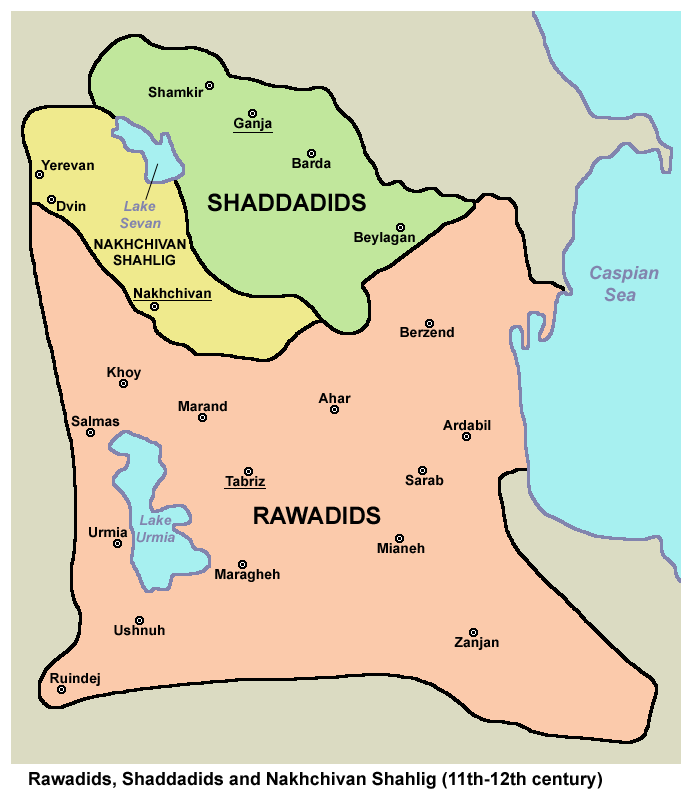The Rawadid dynasty was the first semi-independent Kurdish power in the Middle Ages to emerge in the Azerbaijan region and ruled over a part of Kurdistan. The Rawadis were a tribe belonging to the Kurdish tribe of Hazbani. The government was named after Mohammad Rawadi, the chief of the tribe and its founder. It has been a common phenomenon to name a power after a tribe because, in history, most powers have been named after tribes, clans, families, and regions. The capital of the Rawadid government was Tabriz and its most important cities were Maragheh, Ardebil, Mianj, Urmia, Khoy, Salmas, Saraw, Marand, Bajrwan, and Sisir.
The Rawadid government was the first Kurdish self-government in this historical period. Its fam was due to the weakness of the Abbasid caliphate, the deterioration of the economy, and the administration of the caliphate, despite the region's distance from the capital of the caliphate, Baghdad.
Muhammad son of Hussein Rawadi was the founder and first ruler of the Rawadid government. He established a local authority in Tabriz and its surroundings in 893 AD and ruled an important part of Azerbaijan and part of Kurdistan until 1070 AD by six members of his family. During this period, despite normalizing relations with the Abbasid Caliphate, their relations with the governments of Salari in eastern Azerbaijan, Hazbani in Erbil, and Shaddadi in Aran were extremely tense. In other words, instead of being united to stand against their enemies, the Kurdish emirates were divided. This led to the arrival of the Gazas, a Turkish tribe in Central Asia that appeared in the 12th century AD and invaded the borders of the Abbasid Caliphate. They attacked and invaded Maragheh, burned the great mosque of the city, and killed a large number of Rawadi Kurds and Hazbani; they posed a threat to the government.
This government played a role in many areas during its rule and influenced its time. In terms of the political and administrative system, power was on an inheriting basis from father to son. Whereas, if the Rawadi ruler did not have a son, the power would pass to the brother. The title "Amir" was the title of the rulers of Rawadi, which was actually a political, administrative, and military title. Although historical sources do not mention it, it does not seem that this government lacked a ministerial rank because if the authorities and property owners of this government sealed official letters and documents with gold and paid attention to mail and delivery to carry out their daily affairs and should have the rank of minister or at least adviser.
In terms of military strength, it is mentioned that when Abul Hija Rawadi attacked Abi Dalf, the ruler of Kultan, who had 100,000 soldiers, he defeated him in 987 AD. This shows the extent of the ruler's power and the importance of military force.
Economically, agriculture was an important economic base that played a role in strengthening the government's economic position, as the areas under its control were rich in “agricultural products, grains, and fruits”. In particular, the cities of Tabriz, Ardebil, and Maragheh were among the richest cities of the government. The cities were also known for weaving. The cities of Urmia, Salmas, and Khoy also had a good economic basis for the government. Trade between the cities the government and trade relations between Tabriz and Urmia with the outside of the region and the government gave more value to the foundation of the government.
It also played a role in the field of reconstruction, fortifying its cities with castles and strong bulwarks to withstand the invasions of the invaders. In this regard, Urmia was famous for its Golden Castle. The cities of Salmas, Maragheh, and Ardabil were also surrounded by strong bulwarks. The government also built several mosques and schools.
On the other hand, Friday sermons, a religious duty and a common tradition of the time, were given special importance by the rulers. In Friday sermons, the names of the rulers of Rawadi were read after the names of the Abbasid caliphs. When Togrul Beg Seljuki conquered Tabriz in 1054, the name of the Emir of Rawadi was initially read after the name of the Seljuk Sultan in Friday sermons, but this soon ended the rule.
Sources:
- Kurdish Emirates of the Abbasid Period, Chawarchra Printing House, Sulaimani, 2018
- A Brief History of Kurds, p. Dr. Keywan Azad Anwar, Sulaimani, 2021








